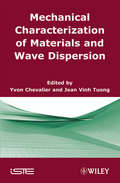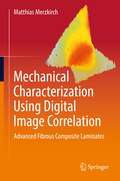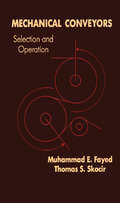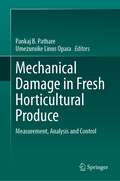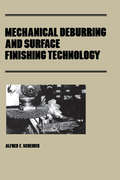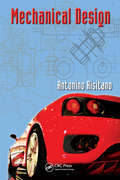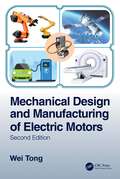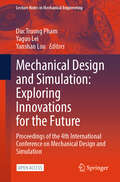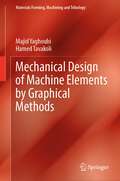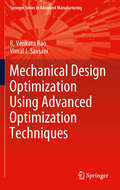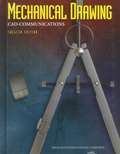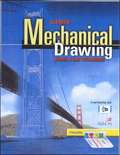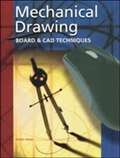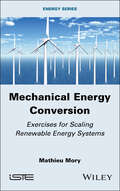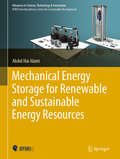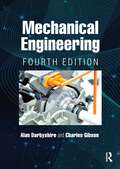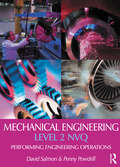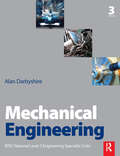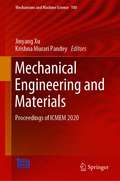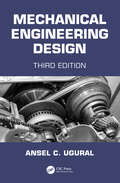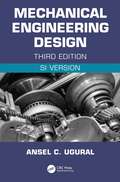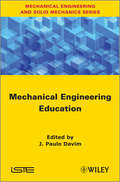- Table View
- List View
Mechanical Characterization of Materials and Wave Dispersion: Instrumentation and Experiment Interpretation
by Yvon Chevalier Jean Tuong VinhOver the last 50 years, the methods of investigating dynamic properties have resulted in significant advances. This book explores dynamic testing, the methods used, and the experiments performed, placing a particular emphasis on the context of bounded medium elastodynamics. Dynamic tests have proven to be as efficient as static tests and are often easier to use at lower frequency. The discussion is divided into four parts. Part A focuses on the complements of continuum mechanics. Part B concerns the various types of rod vibrations: extensional, bending, and torsional. Part C is devoted to mechanical and electronic instrumentation, and guidelines for which experimental set-up should be used are given. Part D concentrates on experiments and experimental interpretations of elastic or viscolelastic moduli. In addition, several chapters contain practical examples alongside theoretical discussion to facilitate the readers understanding. The results presented are the culmination of over 30 years of research by the authors and as such will be of great interest to anyone involved in this field.
Mechanical Characterization Using Digital Image Correlation: Advanced Fibrous Composite Laminates
by Matthias MerzkirchIn this book, a precise treatment of the experimental characterization of advanced composite materials using Digital Image Correlation (DIC) is presented. The text explains test methods, testing setup with 2D- and stereo-DIC, specimen preparation and patterning, testing analysis and data reduction schemes to determine and to compare mechanical properties, such as modulus, strength and fracture toughness of advanced composite materials. Sensitivity and uncertainty studies on the DIC calculated data and mechanical properties for a detailed engineering-based understanding are covered instead of idealized theories and sugarcoated results. The book provides students, instructors, researchers and engineers in industrial or government institutions, and practitioners working in the field of experimental/applied structural mechanics of materials a myriad of color figures from DIC measurements for better explanation, datasets of material properties serving as input parameters for analytical modelling, raw data and computer codes for data reduction, illustrative graphs for teaching purposes, practice exercises with solutions provided online and extensive references to the literature at the end of each stand-alone chapter.
Mechanical Conveyors: Selection and Operation
by Thomas SkocirThis book is a comprehensive, practical guide and reference to today's mechanical conveyor systems. It covers all types of mechanical conveyors, providing in-depth information on their design, function and applications. More than 180 photographs and schematics illustrate details of design and system layout. An introductory chapter provides an understanding of the characteristics of various types of bulk solids, including their conveyability and the types of conveying systems most effective for each. Following chapters examine each of five major categories of conveying systems, with practical details on their design, operation and applications. The final chapter presents basic information on motors and drives for conveying systems, as well as related equipment such as speed reduction systems and conveyor brakes. The emphasis throughout the text is on practical engineering and operating information, with a minimum of theory. The presentation is systematic and organized for easy reference. A very detailed index enables the quick location of needed information. This guide and reference will be useful to all engineers and other personnel involved in the continuous movement of bulk solids. It serves as both a basic introduction and a desk-top reference. The AuthorsDr. Fayed is a Professor and Director of the Powder Science & Technology Group at Ryerson Polytechnic University in Toronto. He is also a licensed Consulting Engineer, a Fellow of the American Institute of Chemical Engineers and the Canadian Society of Chemical Engineering. Previously he held positions in process design and development with ICI, Davy McKee, M. W. Kellogg, and Peabody. He has lectured at numerous seminars and workshops at meetings of the American Institute of Chemical Engineers, and other organizations. He has published many papers on particulate technology and is the co-editor of Powder Science & Technology Handbook. Thomas Skocir in an engineer presently with ECO-TEC
Mechanical Damage in Fresh Horticultural Produce: Measurement, Analysis and Control
by Pankaj B. Pathare Umezuruike Linus OparaThis book includes the impact, compression, vibration studies, and destructive and nondestructive techniques for bruise measurement. It is essential to detect bruises in the early stages of their formation and conduct a quantitative analysis of the degree of bruising, to ensure the accurate grading of bruised fruits and vegetables and reduce unnecessary economic losses. Bruise damage occurring between the point of harvest and consumption contributes the most to the decrease in fruit quality, reducing the market value and ultimately leading to significant reductions in potential revenue. SDG 12.3 aims to “by 2030, halve per capita global food waste at the retail and consumer levels and reduce food losses along production and supply chains, including post-harvest losses.” This book presents recent technological developments in bruise measurement, detection, and analysis of fresh horticultural produce. Given the rising demand for rapid and accurate methods of quality measurement in the horticultural produce industry, this book covers destructive and nondestructive techniques for bruise measurement. Selected applications of different nondestructive methods for various fresh produce commodities are also included. This book will interest graduate and undergraduate students, researchers, academics and engineers working in different aspects of the mechanical damage affected by postharvest handling practices, professionals working in the governments, and other authorities related to fresh horticultural produce quality, regulations, and safety.
Mechanical Deburring and Surface Finishing Technology (Manufacturing Engineering And Materials Processing Ser. #35)
by ScheiderThis handbook focuses on product application principles in the design, development, engineering, and shop floor techniques of deburring, edge contouring, and surface-conditioning methods, systems, and processes highlighting semi-automatic equipment, robotics, automated machinery, and computer-contro
Mechanical Design
by Antonino RisitanoWith a focus on the Italian School of machine design as founded by R. Giovannozzi of Turin Polytechnic, this book provides a complete picture of the necessary components of design, along with the necessary instruments for implementation. It also explains the method of the compact modeling analysis of the mechanical problem. The book provides details from simple fundamentals, to explanation of the design of traditional mechanical components. Topics covered include the methodological statement of engineering, properties of engineering materials, and the design of mechanical components and systems. Case studies are included for the different themes.
Mechanical Design and Manufacture of Hydraulic Machinery (Hydraulic Machinery Series)
by Mei Zu-yanThis volume in the Hydraulic Machinery Book Series covers the most important types of hydraulic machinery: hydraulic turbines for transforming water power to mechanical output; and pumps for producing fluid pressure for many purposes. It describes the features of mechanical design of various types of turbines and pumps. The structure of a hydraulic machine is decided primarily to satisfy the need of fluid flow, so hydraulic characteristics of the machines are also stressed. Manufacturing processes of turbines and pumps and their requirements are referred to in chapters on mechanical construction.
Mechanical Design and Manufacturing of Electric Motors
by Wei TongThis Second Edition of Mechanical Design and Manufacturing of Electric Motors provides in-depth knowledge of design methods and developments of electric motors in the context of rapid increases in energy consumption, and emphasis on environmental protection, alongside new technology in 3D printing, robots, nanotechnology, and digital techniques, and the challenges these pose to the motor industry. From motor classification and design of motor components to model setup and material and bearing selections, this comprehensive text covers the fundamentals of practical design and design-related issues, modeling and simulation, engineering analysis, manufacturing processes, testing procedures, and performance characteristics of electric motors today. This Second Edition adds three brand new chapters on motor breaks, motor sensors, and power transmission and gearing systems. Using a practical approach, with a focus on innovative design and applications, the book contains a thorough discussion of major components and subsystems, such as rotors, shafts, stators, and frames, alongside various cooling techniques, including natural and forced air, direct- and indirect-liquid, phase change, and other newly-emerged innovative cooling methods. It also analyzes the calculation of motor power losses, motor vibration, and acoustic noise issues, and presents engineering analysis methods and case-study results. While suitable for motor engineers, designers, manufacturers, and end users, the book will also be of interest to maintenance personnel, undergraduate and graduate students, and academic researchers.
Mechanical Design and Simulation: Proceedings of the 4th International Conference on Mechanical Design and Simulation (Lecture Notes in Mechanical Engineering)
by Duc Truong Pham Yaguo Lei Yanshan LouThis book is an open access publication. This book presents innovative strategies and cutting-edge research at the intersection of mechanical engineering and simulation technologies. Aimed at addressing the current challenges and limitations in mechanical design, this book presents an array of advanced methodologies and tools that promise to revolutionize the field. From integrating artificial intelligence and machine learning for design optimization to leveraging the latest in finite element analysis for enhanced stress modelling, the proceedings highlight the pivotal role of simulation in pushing the boundaries of what is possible in mechanical design. With a strong emphasis on sustainable design practices and the utilization of additive manufacturing, this collection not only serves as an indispensable resource for engineers, researchers, and students but also marks a significant step forward in bridging the gap between traditional mechanical design principles and modern computational innovations.
Mechanical Design of Machine Elements by Graphical Methods (Materials Forming, Machining and Tribology)
by Majid Yaghoubi Hamed TavakoliThis book covers designing of various machine elements and serves as a reference for mechanical designing of machine elements in academia and industry. It provides information on designing approaches and several examples and problems, enabling readers to make all of their required calculations for their specific mechanical design or fabrication tasks by using the book’s plots (graphs), instead of complicated formulas.
Mechanical Design Optimization Using Advanced Optimization Techniques
by Vimal J. Savsani R. Venkata RaoMechanical design includes an optimization process in which designers always consider objectives such as strength, deflection, weight, wear, corrosion, etc. depending on the requirements. However, design optimization for a complete mechanical assembly leads to a complicated objective function with a large number of design variables. It is a good practice to apply optimization techniques for individual components or intermediate assemblies than a complete assembly. Analytical or numerical methods for calculating the extreme values of a function may perform well in many practical cases, but may fail in more complex design situations. In real design problems, the number of design parameters can be very large and their influence on the value to be optimized (the goal function) can be very complicated, having nonlinear character. In these complex cases, advanced optimization algorithms offer solutions to the problems, because they find a solution near to the global optimum within reasonable time and computational costs. Mechanical Design Optimization Using Advanced Optimization Techniques presents a comprehensive review on latest research and development trends for design optimization of mechanical elements and devices. Using examples of various mechanical elements and devices, the possibilities for design optimization with advanced optimization techniques are demonstrated. Basic and advanced concepts of traditional and advanced optimization techniques are presented, along with real case studies, results of applications of the proposed techniques, and the best optimization strategies to achieve best performance are highlighted. Furthermore, a novel advanced optimization method named teaching-learning-based optimization (TLBO) is presented in this book and this method shows better performance with less computational effort for the large scale problems. Mechanical Design Optimization Using Advanced Optimization Techniques is intended for designers, practitioners, managers, institutes involved in design related projects, applied research workers, academics, and graduate students in mechanical and industrial engineering and will be useful to the industrial product designers for realizing a product as it presents new models and optimization techniques to make tasks easier, logical, efficient and effective. .
Mechanical Drawing: CAD Communications (12th Edition)
by Thomas E. French Jay D. Helsel Carl L. Svensen Byron UrbanickThe nation's #1 drafting text – first published in 1919. The twelfth edition combines basic drafting elements and concepts with modern advancements in the technologies of the industry. Empowers students to move successfully from school to work by helping them visualize in three dimensions, build imaginations, think precisely, and understand the language of the industry.
Mechanical Drawing: CAD Communications (12th Edition)
by Thomas E. French Carl L. Svensen Jay D. Helsel Byron UrbanickThe nation's #1 drafting text – first published in 1919. The twelfth edition combines basic drafting elements and concepts with modern advancements in the technologies of the industry. Empowers students to move successfully from school to work by helping them visualize in three dimensions, build imaginations, think precisely, and understand the language of the industry.
Mechanical Drawing: Board & CAD Techniques
by Jay D. HelselProject-based learning prepares students for professional certification with Glencoe Mechanical Drawing: Board and CAD Techniques! Endorsed by the American Design Drafting Association (ADDA), this text includes Prep for ADDA activities. Step-by-step applications, design problems, and drafting problems prepare students for professional excellence and certification. Project-based learning is supported with unit-based projects that integrate technical math and culminate in Build Your Portfolio activities. Help your students get ready for competitive events like the TSA and SkillsUSA with prep activities embedded throughout the content and end-of-chapter assessments. Rigorous academic content is supported, with a special emphasis on math, geometry, and science, with STEM activities. Point-of-use correlations ease possible academic credit application. Extra activities in the Student Edition and workbook help you meet Perkins mandates. The appendix features Math (including algebra and geometry), abbreviations and symbols, pipe symbols, and reference tables (ASME, ANSI, ISO).
Mechanical Drawing Board and CAD Techniques (13th Edition)
by Thomas E. French Jay D. HelselThis completely revised comprehensive drafting book for high school includes solid drafting instruction, board drafting techniques, and computer aided drafting techniques. Each chapter provides a large number of practice problems, "Tech Math" incorporating math skills needed for the covered topics, and "Success on the Job" employability skills needed on the job.
Mechanical Energy Conversion: Exercises for Scaling Renewable Energy Systems
by Mathieu MoryThis book studies the principles of mechanical energy conversion used in renewable energy sources derived from air and water: wind power, tidal power, hydroelectric power, osmotic energy, ocean thermal energy and wave energy. Mechanical Energy Conversion presents twelve application exercises and their answers. They enable the reader to first understand the physical principles of mechanical energy converters and then learn the method for sizing them. The book also reinforces the concepts of fluid mechanics and hydraulic turbo machinery, which are required to solve the exercises. This book aims to instruct readers on how to design an energy system. For each renewable energy source covered – and based on the quantity of energy or power supplied – it describes the production process, explains how it works and calculates the characteristics and dimensions of its components.
Mechanical Energy Storage for Renewable and Sustainable Energy Resources (Advances in Science, Technology & Innovation)
by Abdul Hai AlamiThe available literature on energy storage technologies in general, and mechanical energy storage in particular, is lacking in terms of both quantity and quality. This edited volume focuses on novel (yet uncomplicated) ideas that are currently part of the Energy Storage curriculum at the University of Sharjah, UAE. These techniques have been extensively researched and their prototypes are central to the undergraduate Energy Storage Lab that is associated with the course. Although ideally suited for wind energy storage, the techniques described are also suitable for renewable energy storage in general, and offer high two-way efficiency ratings.
Mechanical Engineering
by Alan Darbyshire Charles GibsonNow in its fourth edition, Mechanical Engineering has been revised to be in line with the technical qualifications of the new engineering apprenticeship standards at Level 3. In addition, four new chapters are included that cover static and dynamic engineering systems, fluid systems and additive manufacturing. The text covers eight units of the BTEC L3 Advanced Manufacturing Engineering Development Technical Knowledge qualification, as well as some content in the BTEC National Engineering Syllabus and BTEC L3 Aerospace and Aviation Engineering specialist qualifications. It also covers some of the content in the EAL L3 Advanced Manufacturing Engineering Development Technical Knowledge qualification. To enhance learning, mathematical theory is backed up with numerous examples to work through. There are also activities for students to complete out of the classroom that help put the theory into context. Test your knowledge quizzes throughout the text enable students to test their understanding, while end of unit review questions are helpful for exam revision and course work. This book is ideal for students undertaking Level 3 courses in engineering although students undertaking Level 4 engineering courses will also find the content of the book useful to their studies. Alan Darbyshire is a retired Further Education lecturer and experienced textbook author for Intermediate GNVQ and AVCE. He drafted several of the mechanical engineering units for the BTEC National specifications. Charles Gibson completed an aeronautical mechanical engineering apprenticeship, and then spent 16 years in the Royal Navy maintaining military helicopters before retiring from the military in 2008. Since then, he has worked in Further Education as the Head of Aeronautical Engineering at City of Bristol College where he also taught on several programmes, including BTECs in Aeronautical Engineering and Foundation Degrees. In 2013, he transferred to Yeovil College where he continues to teach on engineering programmes from Level 2 to Level 5. He has also been involved in the writing of engineering technical knowledge qualifications for several engineering apprenticeship standards.
Mechanical Engineering: Level 2 NVQ
by David Salmon Penny PowdrillA thoroughly accessible and engaging workbook-style text, ideal for all NVQ students, including Foundation Modern Apprentices. Mechanical Engineering: Level 2 NVQ is a practical and interactive engineering book, written by practicing lecturers and designed for college students and Foundation Modern Apprentices. A highly readable text is supported by numerous assignments provided to build up a portfolio of evidence. Designed so that students can complete the blanks this book can be used as evidence for assessment purposes and as an essential reference guide for their subsequent employment. This book covers the mandatory units (1-3), general support units (4-5) and option units (10-12) required to deliver a full NVQ programme. Key Skills activities are also provided at the relevant points through the book.Mechanical Engineering: NVQ2 is a new single-volume text for the new Performing Engineering Operations NVQs from EMTA and City & Guilds updated and expanded from David Salmon's popular NVQ titles:NVQ Engineering Manufacture: Mandatory UnitsNVQ Engineering: Mechanical Option Units
Mechanical Engineering (3rd Edition)
by Alan DarbyshireThe most popular specialist mechanical units of the BTEC National Engineering in one book! Clear, full colour layout and numerous examples, activities, quizzes and review questions with answers make it easy for students to learn and revise for their exams Each chapter covers one unit of the syllabus and contains all the learning outcomes Content you can trust – written by an experienced lecturer involved in the development of the syllabus The third edition of this established textbook fully covers the 6 most popular specialist units of the Mechanical Engineering, Manufacturing Engineering and Operations and Maintenance Engineering pathways of the BTEC National Engineering syllabus. Units covered: Unit 8 – Engineering Design, Unit 10 Properties and Applications of Engineering Materials, Unit 11 – Further Mechanical Principles and Applications, Unit 12 – Applications of Mechanical Systems and Technology, Unit 15 – Electro, Pneumatic and Hydraulic Systems and Devices, Unit 18 – Advanced Mechanical Principles and Applications. Mathematical theory is backed up with numerous examples to work through. There are also activities for students to complete out of the classroom which help put theory into context. The activities have been thoroughly revised in line with the new assessment ad grading criteria. Test your Knowledge quizzes throughout the text enable the students to test their understanding as they work through the book, while end of unit review questions are ideal for exam revision and course work.
Mechanical Engineering and Materials: Proceedings of ICMEM 2020 (Mechanisms and Machine Science #100)
by Jinyang Xu Krishna Murari PandeyThis book gathers the latest advances, innovations, and applications in the field of mechanical engineering, as presented by leading international researchers and engineers at the 2020 International Conference on Mechanical Engineering and Materials (ICMEM), held in Beijing, China on October 16-17, 2020. ICMEM covers all aspects of mechanical engineering and material sciences, such as computer-aided design, virtual design and design visualization, intelligent design, usability design, automobile structure, human-machine interface design, manufacturing engineering, aerospace engineering, automation and robotics, micro-machining, MEMS/ NEMS, composite materials, biomaterials, smart materials, superconducting materials, materials properties and applications, materials manufacturing, nanotechnology, nano-materials and nano-composites, etc. The contributions, which were selected by means of a rigorous international peer-review process, highlight numerous exciting ideas that will spur novel research directions and foster multidisciplinary collaborations.
Mechanical Engineering Design: Third Edition (Mcgraw-hill Series In Mechanical Engineering)
by Ansel C. UguralMechanical Engineering Design, Third Edition strikes a balance between theory and application, and prepares students for more advanced study or professional practice. Updated throughout, it outlines basic concepts and provides the necessary theory to gain insight into mechanics with numerical methods in design. Divided into three sections, the text presents background topics, addresses failure prevention across a variety of machine elements, and covers the design of machine components as well as entire machines. Optional sections treating special and advanced topics are also included. Features: Places a strong emphasis on the fundamentals of mechanics of materials as they relate to the study of mechanical design Furnishes material selection charts and tables as an aid for specific uses Includes numerous practical case studies of various components and machines Covers applied finite element analysis in design, offering this useful tool for computer-oriented examples Addresses the ABET design criteria in a systematic manner Presents independent chapters that can be studied in any order Introduces optional MATLAB® solutions tied to the book and student learning resources Mechanical Engineering Design, Third Edition allows students to gain a grasp of the fundamentals of machine design and the ability to apply these fundamentals to various new engineering problems.
Mechanical Engineering Design (SI Edition)
by Ansel C. UguralMechanical Engineering Design, Third Edition, SI Version strikes a balance between theory and application, and prepares students for more advanced study or professional practice. Updated throughout, it outlines basic concepts and provides the necessary theory to gain insight into mechanics with numerical methods in design. Divided into three sections, the text presents background topics, addresses failure prevention across a variety of machine elements, and covers the design of machine components as well as entire machines. Optional sections treating special and advanced topics are also included. Features: Places a strong emphasis on the fundamentals of mechanics of materials as they relate to the study of mechanical design Furnishes material selection charts and tables as an aid for specific utilizations Includes numerous practical case studies of various components and machines Covers applied finite element analysis in design, offering this useful tool for computer-oriented examples Addresses the ABET design criteria in a systematic manner Presents independent chapters that can be studied in any order Mechanical Engineering Design, Third Edition, SI Version allows students to gain a grasp of the fundamentals of machine design and the ability to apply these fundamentals to various new engineering problems.
Mechanical Engineering Education: Research, Development And Education (Wiley-iste Ser. #757)
by Paulo DavimMechanical Engineering is defined nowadays as a discipline “which involves the application of principles of physics, design, manufacturing and maintenance of mechanical systems”. Recently, mechanical engineering has also focused on some cutting-edge subjects such as nanomechanics and nanotechnology, mechatronics and robotics, computational mechanics, biomechanics, alternative energies, as well as aspects related to sustainable mechanical engineering. This book covers mechanical engineering higher education with a particular emphasis on quality assurance and the improvement of academic institutions, mechatronics education and the transfer of knowledge between university and industry.
Mechanical Engineering for Makers: A Hands-on Guide to Designing and Making Physical Things
by Brian Bunnell Samer NajiaThis practical, user-friendly reference book of common mechanical engineering concepts is geared toward makers who don't have (or want) an engineering degree but need to know the essentials of basic mechanical elements to successfully accomplish their personal projects. The book provides practical mechanical engineering information (supplemented with the applicable math, science, physics, and engineering theory) without being boring like a typical textbook. Most chapters contain at least one hands-on, fully illustrated, step-by-step project to demonstrate the topic being discussed and requires only common, inexpensive, easily sourced materials and tools. Some projects also provide alternative materials and tools and processes to align with the reader's individual preferences, skills, tools, and materials-at-hand. Linked together via the authors' overarching project -- building a kid-sized tank -- the chapters describe the thinking behind each mechanism and then expands the discussions to similar mechanical concepts in other applications. Written with humor, a bit of irreverence, and entertaining personal insights and first-hand experiences, the book presents complex concepts in an uncomplicated way.Highlights include:Provides mechanical engineering information that includes math, science, physics and engineering theory without being a textbookContains hands-on projects in each chapter that require common, inexpensive, easily sourced materials and toolsAll hands-on projects are fully illustrated with step-by-step instructionsSome hands-on projects provide alternative materials and tools/processes to align with the reader's individual preferences, skills, tools and materials-at-handIncludes real-world insights from the authors like tips and tricks ("Staying on Track") and fail moments ("Lost Track!")Many chapters contain a section ("Tracking Further") that dives deeper into the chapter subject, for those readers that are interested in more details of the topicBuilds on two related Make: projects to link and illustrate all the chapter topics and bring individual concepts together into one systemFurnishes an accompanying website that offers further information, illustrations, projects, discussion boards, videos, animations, patterns, drawings, etc.Learn to effectively use professional mechanical engineering principles in your projects, without having to graduate from engineering school!
